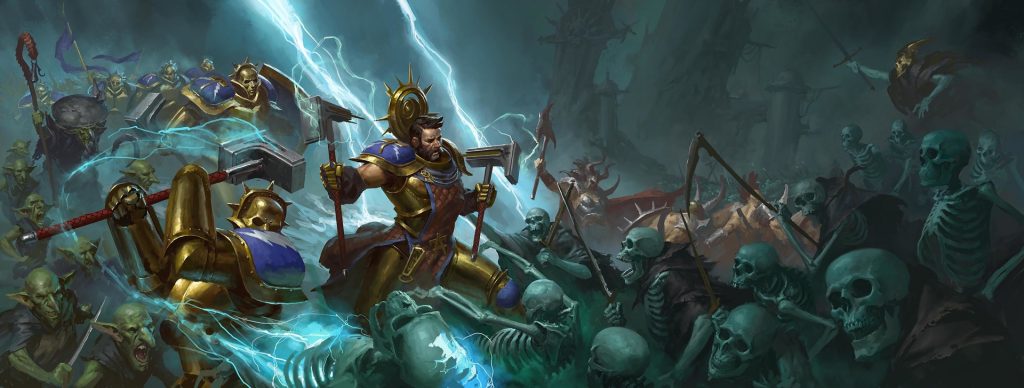Cubicle 7 Discuss Opposed Tests In Age Of Sigmar: Soulbound
May 28, 2019 by brennon
Cubicle 7 has been discussing more of the mechanics behind their new Age Of Sigmar Roleplaying Game, Soulbound. This time around they looked at Opposed and Group tests.
Opposed Tests work very similarly to traditional tests although success is simply dictated by who gets the most successes. The defender, in cases where you have a tie, also comes out on top.
Here is the example that Cubicle 7 shared.
"Ahnika, a Witch Aelf of the Daughters of Khaine, is trying to escape an enraged Skaven Rat Ogor. She darts through the doorway of a crumbled warehouse in the Anvilgard docks and slams the door behind her, trying to hold it closed. The Rat Ogor roars and starts smashing its fists against the door, splintering the wood. The GM calls for an Opposed Test between Ahnika and the Rat Ogor to see if Ahnika can hold the door closed.
The GM decides that it is a DN 4 Body (Might) Opposed Test for both participants. Ahnika has Body 3 but is not Trained in the Might Skill, giving her a dice pool of just 3. The Rat Ogor has Body 5 and has one level of Trained in Might, giving it a dice pool of 6. Ahnika rolls a gets a result of 2, 4, and 5, giving her two successes (4 and 5). The GM rolls for the Rat Ogor and gets a result of 1, 3, 4, 5, 6, and 6, giving it four successes (4, 5, 6, and 6). The Rat Ogor wins the Opposed Test and smashes the warehouse door to pieces. Ahnika recoils from the splintering wood and starts running again."
Advantage, as mentioned here in this example, is a nice and easy concept to get your head around too. If you have advantage then the test DN is reduced by one. If the test is made at disadvantage then you simply increase the DN by one.
This means that if your players come up with inventive and interesting ways to solve a problem then they are likely to pass their tests; a nice way to reward ingenuity and thinking outside the box.
Group Tests allow you to all work together towards a common goal. All of your relevant skills can be pooled into a test like this which usually means around two success per individual involved.
"This means the typical DN for a Group Test for a party of four would be DN 4:8 (difficulty 4, requiring 8 successes total)"
This means that if things are getting really hectic and you want to see how the group works as a whole you can simply the action into one set of rolls rather than rushing around the table to resolve each element moment by moment.
I can see why people have been saying that a greater range of results from a D10 would have been interesting here but I think that this system will be nice and easy to get into. I feel like I've already got a handle on it and we've only read a couple of preview articles! The proof will certainly be in the pudding though so we'll wait and see how it all unfolds nearer release.
Are you interested in what Cubicle 7 are working on for Soulbound?
"I think that this system will be nice and easy to get into..."
Supported by (Turn Off)
Supported by (Turn Off)
Supported by (Turn Off)































![TerrainFest 2024 Begins! Build Terrain With OnTableTop & Win A £300 Prize! [Extended!]](https://images.beastsofwar.com/2024/10/TerrainFEST-2024-Social-Media-Post-Square-225-127.jpg)












































If it improves the game its worth trying.